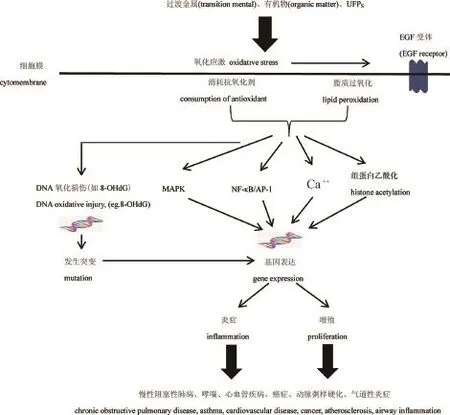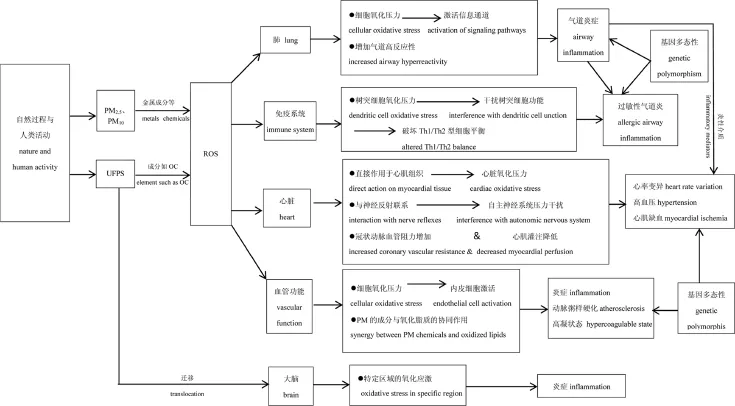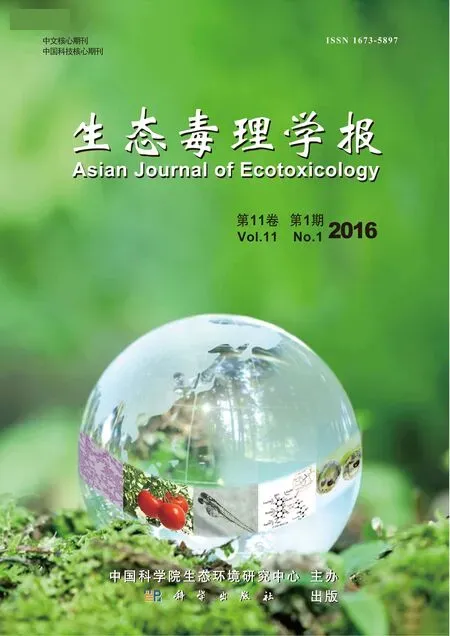大氣顆粒物物理化學屬性致病效應與損傷機制的研究進展
付鎧,周啟星,胡獻剛
南開大學環境科學與工程學院,環境污染過程與基準教育部重點實驗室,天津市城市生態環境修復與污染防治重點實驗室,天津300071
大氣顆粒物物理化學屬性致病效應與損傷機制的研究進展
付鎧,周啟星,胡獻剛*
南開大學環境科學與工程學院,環境污染過程與基準教育部重點實驗室,天津市城市生態環境修復與污染防治重點實驗室,天津300071
近些年,我國大氣顆粒物所帶來的健康問題越發突出,由此產生的環境疾病日益引起人們的廣泛關注。大量的流行病學和毒理學研究發現,大氣顆粒物能引起呼吸系統、心血管系統、神經系統、免疫系統等的損傷,造成新生兒出生缺陷,增加罹患癌癥的風險,且與人群發病率和死亡率上升有關。但是由于大氣顆粒物物化屬性比較復雜,一種或幾種損傷機制并不能完全解釋其與致病效應的關系,因此具體的損傷機制目前還沒有統一的說法,大氣顆粒物物理化學屬性與致病效應的關系仍在探索當中。本文從大氣顆粒物的粒徑、濃度、比表面積、來源、成分等基本屬性入手,剖析其基本特點和可能影響健康的原因,探討大氣顆粒物通過氧化損傷途徑誘導致病效應,并結合當前大氣顆粒物健康影響研究現狀提出在未來研究中應注重的相關內容。
顆粒物;環境疾病;損傷機制;氧化損傷;ROS;PM2.5
空氣污染可以產生不良的健康影響,引起人群發病率和死亡率上升,誘發呼吸系統和心腦血管疾病[1]。大量的流行病學和毒理學研究表明,空氣污染物中的顆粒物物理化學屬性起到了關鍵作用[2]。大氣顆粒物中包含化學成分不同、粒徑各異的顆粒狀物質,粒徑較大的顆粒物不是一個粒子,而是一個粒子束,是由多個粒徑較小的顆粒構成的組合體[3],因此大氣顆粒物實際上是粒徑范圍寬、物理化學性質復雜的顆粒聚集體[4]。2013年10月,世界衛生組織(World Health Organization,WHO)下屬的國際癌癥研究機構(International Agency for Research on Cancer,IARC)正式將大氣顆粒物列為I級(Group I)致癌物,認為它是產生環境健康問題的主要原因和分布較為廣泛的環境致癌物[5]。
大氣顆粒物的致病機理非常復雜,一種或幾種損傷機制很難完全解釋大氣顆粒物對人體健康的影響,因此顆粒物對健康影響的毒理學效應并不十分清楚[6]。顆粒物的來源、種類、粒徑、化學成分、濃度及暴露時間等都有可能是影響人體健康的原因,基于此假設,國內外利用流行病學、毒理學實驗和各類模型針對顆粒物的物理化學屬性開展了系統廣泛的深入研究,已有的研究成果充分表明顆粒物引起的不利健康影響主要歸因于顆粒物的數量、粒徑、化學成分、水溶性等物理化學屬性[7-8]。最終導致呼吸系統、心腦血管系統疾病,造成神經系統和免疫系統功能降低,對胃腸道和皮膚產生刺激癥狀,引發兒童出生缺陷、發育遲緩、早逝等[9-11]。表1列出了近幾年研究人員針對大氣顆粒物對健康影響的最新研究成果。
由于大氣顆粒物具有復雜的物理化學屬性,每種屬性都會導致人體出現損傷,且各種屬性之間相互作用,產生協同效果,加重損傷程度,為準確研究大氣顆粒物物理化學屬性與致病效應的關系增加了難度。本文基于已有研究成果,梳理國內外關于大氣顆粒物對人體和動物的各種損傷機制及致病機理,著重分析大氣顆粒物的基本屬性與其致病性的關系和氧化損傷機制,為今后我國全面深入開展相關研究提供參考。
1 大氣顆粒物物理屬性的致病效應(The physical properties of atmospheric particulate matters for health effects)
大氣中顆粒物的劃分通常用空氣動力學直徑表示,在一定體積空氣中,空氣動力學直徑≤100μm的所有懸浮顆粒物統稱為總懸浮顆粒物(total suspended particulate,TSP)。大氣中的顆粒物由一系列不同粒徑的顆粒構成,包括可吸入顆粒物(inhalable particulate matter,空氣動力學直徑<10μm,PM10)、粗顆粒物(coarse particulate matter,空氣動力學直徑在2.5~10μm之間,PM2.5-10)、細顆粒物或可吸入肺顆粒物(fine particulate matter,空氣動力學直徑<2.5μm,PM2.5)和超細顆粒物(ultrafine particles matter, UFPs,空氣動力學直徑<0.1μm,PM0.1)[12-13]。大氣顆粒物的物理屬性主要包括形狀、質量、濃度、粒子數目、粒徑、表面積和比表面積等,不同的物理屬性可能對人體的作用機制不同,下面主要從濃度、粒徑和比表面積3個方面簡要介紹[14]。
1.1 濃度
流行病學和毒理學的研究表明,顆粒物的質量濃度(mass concentrations,MC)與呼吸系統和心肺疾病的發病率、死亡率存在著正相關關系,對于那些易感人群、兒童和老人這種關系尤為明顯[15-16]。我國在1996年頒布的環境空氣質量標準(GB3095-1996)規定PM10二級標準為年均值100μg·m-3、日均值150μg·m-3。1997年,美國環境保護署(EnvironmentalProtection Agency,US EPA)率先推出了PM2.5的大氣環境質量標準,即年均值15μg·m-3,日均值65μg·m-3[17]。WHO在2005年版《空氣質量準則》中指出:當PM2.5年均濃度達到35μg·m-3時,人的死亡風險比10μg·m-3的情形增加約15%,由此可見,大氣顆粒物的健康危害不容忽視。將于2016年1月1日正式實施的最新環境空氣質量標準(GB3095-2012),規定我國PM2.5的二級標準為日均值75μg·m-3,年均值35μg·m-3,該標準將為評估我國的PM2.5污染水平提供重要參考,加快推進我國大氣污染治理,從而切實保障人民群眾的身體健康。
大量的流行病學研究發現了大氣顆粒物濃度與健康影響的關系。Chen等[18]利用模型對我國16個城市的研究發現,大氣PM10每增加10μg·m-3,居民總死亡率增加0.35%,由心血管疾病引發的死亡率增加0.44%,由呼吸系統疾病引發的死亡率增加0.56%。Sorensen等[19]則歷時一年多對50名學生進行跟蹤研究和分析,發現在適當的濃度下,顆粒物可以發生氧化應激,生成多環芳烴加合物,從而對淋巴細胞的DNA產生損傷。同樣,Bernatsky等[20]通過對蒙特利爾237名患者,研究PM2.5濃度對全身性紅斑狼瘡的臨床影響時發現,PM2.5濃度水平可以影響人體自身免疫系統,引發全身性紅斑狼瘡和風濕性疾病等免疫系統疾病。

表1 大氣顆粒物對健康影響的研究成果Table 1 Health effects of atmospheric particulates
數量濃度(number concentrations,NC)是確定大氣顆粒物對氣候和健康影響的關鍵參數,但在實際評價過程中多以質量濃度作為衡量指標,因此數量濃度往往被忽略[21]。研究表明,粒徑小的顆粒物,其數量濃度占總數量濃度的比例較高,而粒徑大的顆粒物,其質量濃度占總質量濃度的比例較高,由于粒徑小的顆粒物其致病性更強,由此可推斷出顆粒物數量濃度與健康效應的關系比質量濃度更具相關性[21]。Karottki等[22]研究微環境顆粒物對老年人的影響時觀察到連續48 h顆粒物數量濃度增加,微血管功能可以降低8%。Strak等[23]將健康的志愿者暴露于大氣顆粒物2 h,運用模型研究發現,數量濃度的改變與急性呼吸道炎癥和肺功能損傷有密切關聯。
1.2 粒徑
粒徑是研究顆粒物屬性及致病性的主要分類依據,其不僅是劃分大氣顆粒物的重要指標,也是氣溶膠行為最重要的參數,顆粒物幾乎所有的物化特性和生物有效性都與其粒徑尺度有關。顆粒物的粒徑分布很廣,跨越4個數量級,大量的流行病學和毒理學表明,顆粒物的粒徑越小毒性越強,不同粒徑的顆粒物由于穿透性不同隨人體呼吸分布在呼吸道的不同位置,其中被人體吸入的超細顆粒物60%~80%可以在肺泡被吸收[9,24-26]。PM10通常可以進入鼻腔、咽喉,沉積在上呼吸道、氣管和主支氣管中;PM2.5-10可以進入呼吸道,但部分會隨著人們吐痰、咳嗽、打噴嚏而被排出;75%的PM2.5主要沉積在細支氣管、肺泡,但其中更細的成分還可以穿過肺泡進入到血液,滲透到細胞壁[14-15,26-27];PM0.1甚至可以利用上皮細胞和內皮細胞通過轉胞吞作用進入血液和淋巴循環,分布到全身各處,隨后影響骨髓、淋巴結、脾臟和心臟等大部分組織和器官的潛在靶點[9,26]。Boman等[28]通過梳理數據庫中關于住宅區燃燒木材產生的顆粒物引起各種健康影響的相關文獻,發現急性哮喘與粒徑小于10μm的顆粒物有關。Oberdorster等[29]則通過實驗發現熱降解聚四氟乙烯產生的超細顆粒物(直徑中值26 nm),老鼠暴露10~30 min后與較大粒徑的顆粒物相比更能引起出血性肺炎甚至死亡。同樣,Castro等[30]對體育場館內使用氧化鎂干燥劑所產生的顆粒物對館內人員的影響進行研究,發現所產生的顆粒物粒徑大部分大于1μm或亞微米,這些顆粒物并沒有到達肺泡,而是主要保留在了氣管和支氣管內。雖然這些顆粒物由于粒徑較大沒有進入肺泡,但是研究認為也會使人體產生神經系統紊亂、心臟障礙、呼吸道刺激等癥狀。
1.3 比表面積
毒理學實驗表明,比表面積是大氣顆粒物的重要物理化學屬性,可以控制人體和動物的有毒有害物質的暴露量,是評價毒理效應的重要參數[31-32]。大氣顆粒物尤其是超細顆粒物由于其特殊的納米特性危害較為明顯,在相同質量濃度下,大氣顆粒物的粒徑越小,其比表面積越大,越易吸附有毒、有害物質,使顆粒物的毒性增強[2]。這些被吸附的有毒、有害物質可直接隨呼吸進入人體并沉積于肺部,也可以通過皮膚或毛囊進入體內,進而利用血液循環沉積在肝臟、心臟、脾臟等器官,產生氧化損傷和炎性反應,打破系統的自主平衡,對心肺系統和神經系統等產生更大的危害[1,16]。Chuang等[33]利用3種粒徑的黑碳(black carbon,BC)研究對自發性高血壓大鼠的毒理效應,發現粒徑越小黑碳的比表面積越大,且比表面積的大小與氧化應激、DNA單鏈損傷和炎性反應存在一定關系,認為比表面可以作為研究黑碳對大鼠毒理效應的劑量標準。同樣,Stoeger等[25]定量比較碳質超細顆粒物的急性損傷時發現,比表面積與老鼠的炎性反應存在明顯的劑量響應。但是Topinka等[34]對東歐4個城鎮大氣中致癌性揮發有機物的基因毒性進行研究時發現,雖然超細顆粒物在所研究的4個粒徑段中粒徑最小,擁有最大的比表面積,但是卻沒有攜帶最多的致癌性揮發有機物,也不是誘導基因毒性最主要的物質,這一重要發現與已有研究略有不同,對全面研究大氣顆粒物尤其是超細顆粒物的毒性和健康影響具有重要意義。
2 大氣顆粒物來源的致病效應(The sources of atmospheric particulate matters for health effects)
大氣顆粒物的來源、發生量及暴露水平會因不同國家和地區的地理位置、季節、氣象條件、經濟發展程度、能源結構、工藝方法、人口結構、生活習俗以及管理水平等的不同而存在很大的差異[10,16]。大氣顆粒物的來源主要有2個方面:自然過程和人類活動[35]。自然過程包括火山活動、山林火災、海嘯、沙塵暴、揚塵、土壤和巖石風化以及大氣圈的空氣運動等;人類活動包括化石燃料燃燒、工業生產、建筑施工、采礦、生物質燃料燃燒等生產活動和生活活動2方面[11,36-37]。
不同來源的大氣顆粒物,具有不同的物理化學屬性,利用這些屬性可以分析特定來源的顆粒物與健康影響之間的關系。Bell等[38]通過研究美國4個城市的孕婦懷孕期暴露的顆粒物,認為汽車燃料燃燒釋放的鋅(Zn)、硅(Si)、鋁(Al)等物質與出生嬰兒的體重偏低有關。Wu等[39]則更加全面的研究了各種排放源,通過對21名大學生從郊區到市區遷移過程中早晚呼氣流量峰值的跟蹤研究,發現交通排放的銅(Cu),工業排放的銅(Cu)和鎘(Cd),煤燃燒產生的砷(As),長距離輸送的灰塵所含的錫(Sn)可以明顯降低肺部功能,對呼吸系統影響顯著。Tapanainen等[40]通過分析小型木材燃燒設備,認為其產生的顆粒物可以導致細胞程序性死亡并引起DNA損傷。同樣,Taner等[41]對14個采用木炭燃燒的餐廳排放的顆粒物研究發現,砷(As)和鉻(Cr(VI))的致癌風險異常高,應引起從業人員的重視。Michael等[42]則對來自城市和農村的大氣顆粒物進行實驗分析,發現來自城市的顆粒物比來自農村的顆粒物更能降低肺部齒槽上皮細胞(A549)和小鼠巨噬細胞(RAW264.7)的活力,同時更易誘發炎性反應和增加氧化損傷。但是,Libalova等[43]認為不同來源的顆粒物中有機物組分對肺成纖維細胞(HEL12469)染毒后,一些個體基因轉錄的劑量-應答關系增強,但是這些轉錄的數據并沒有因有機物組分的來源不同而呈現出不同的差異,由此推測不同來源的顆粒物可能有相同的生物效應。
3 大氣顆粒物化學屬性的致病效應 (The chemical properties of atmospheric particulate matters for health effects)
大氣顆粒物的組分復雜,呈現出不均勻的“雞尾酒”效應[16],各個研究領域對其組分的劃分不盡相同,但主要包括有機成分、無機成分、水溶性成分和非水溶性成分等[44]。不同化學組分的顆粒物因其特定的屬性對環境、健康的影響亦不盡相同,調整顆粒物各組分的比例,可以發現會產生不同的健康影響[45]。下面主要從碳成分、重金屬、水溶性離子3個方面對大氣顆粒物的化學組分與其致病性的關系進行分析。
3.1 碳成分
碳成分是大氣顆粒物的重要組成部分,約占整個大氣顆粒物的10%~70%左右[46],主要由含碳組分經不完全燃燒或光化學反應生成,其分類、主要存在形式及來源如表2所示[47-48]。
3.1.1 有機碳
有機碳(organic carbon,OC)主要來自污染源直接排放的一次有機碳(primary organic carbon,POC)和由揮發性碳氫化合物經過光化學反應形成的二次有機碳(secondary organic carbon,SOC)。大氣顆粒物中含有較多的具有“三致”特點的有毒有害有機物,其中危害較大的是多環芳烴(polycyclic aromatic hydrocarbons,PAHs)及其衍生物,US EPA已將6種多環芳烴歸為極可能致癌物,苯并[a]芘(BaP)是致癌性PAHs中致癌強度比較高的一種,通常將其作為所有致癌性PAHs的指示物,WHO規定的BaP日均值標準為1 ng·m-3。
目前,針對有毒有害有機物的健康影響,國內外開展了許多相關的流行病學和毒理學研究。Chen等[49]對12 982例缺血性中風患者研究發現,在暖季OC的急診率。Faiola等[50]認為顆粒物中的蒽與鐵離子具有某種協同作用,可以對線粒體產生一定的損傷。同樣,Andreau等[51]通過實驗發現PM2.5攜帶的芳香烴類成分可以模仿細胞凋亡的過程,其通過刺激芳香烴受體參與線粒體抗細胞凋亡過程,這一過程可能會誘導炎性損傷修復過程的延遲。另外, Libalova等[43]通過對實驗得到的基因表達譜進行研究分析,認為PM2.5中的有機組分可以刺激人類胚胎肺成纖維細胞中芳香烴受體依賴的基因過度表達。
3.1.2 元素碳
元素碳(elemental carbon,EC)是無機碳(inorganic carbon,IC)的一種,主要以石墨化碳和炭黑形式存在,它們大多存在于小粒子中,具有較大的比表面積。EC既能充當其他物質參與光化學反應的催化劑,同時也可吸附其他有毒有害物質或者作為致病菌的載體攜帶病菌對人體健康造成危害[52]。運用模型進行分析,在單重或多重模型中EC是和死亡率最相關的顆粒物成分;同時研究也發現,在兒童出生后的2年,EC與兒童在寒冷季節時的咳嗽有關[36]。
3.1.3 黑碳
黑碳可認為是EC的一種,主要是含碳物質(如石油、煤、木炭、柴草、塑料垃圾、動物糞便等)不完全燃燒發生熱解的產物,在掃描電鏡下黑碳呈現出亞微米級的顆粒物聚合體(團狀或者鏈狀)。在研究應用中,BC往往輔助PM2.5等作為指示空氣質量標準的指標,對于其致病研究相對較少[53]。其中,Hua等[54]在上海利用模型研究發現,無論是在單污染模型還是復合污染模型,BC對兒童產生的急性哮喘影響要比PM2.5強。Jung等[55]認為,室內較高濃度的PM2.5可以導致5~7歲的兒童出現咳嗽,而BC被認為可能導致了這種癥狀的出現。Saputra等[56]對吸入黑碳顆粒物的小鼠肺部進行組織病理學研究,發現纖連蛋白mRNA的表達非常顯著,最終加重肺部炎癥。Chuang[33]等通過研究認為,黑碳可以穿過氣血屏障,造成自發性高血壓大鼠產生應激反應和周邊血液細胞的DNA損傷,引起肺部細胞炎性反應和細胞中毒,同時改變細胞的滲透性等。
3.2 重金屬
有毒重金屬可以通過水、空氣和食物等載體進入人體[57]。在這3種方式中,尤其以空氣吸入、皮膚滲透的方式最需要引起人們的關注,但往往由于各種原因此種方式又最容易被忽視。大氣顆粒物所含的重金屬致毒性極強,很多毒理學實驗已經表明金屬元素是大氣顆粒物中造成危害的重要組分,其可通過呼吸作用進入人體,與人體中的蛋白質、DNA及RNA反應,抑制酶素或改變代謝物質的催化分解速率,或與其他物質反應產生各種機能障礙,導致兒童身體發育遲緩,甚至引發心臟病和各種癌癥,對人類健康造成很大威脅[58-59]。不同的暴露方式可以產生不同的健康影響,暴露于高濃度重金屬下常會產生不可逆轉的急性毒性,即使是在低濃度的重金屬環境中,長期暴露也會造成慢性中毒,嚴重影響健康[60]。
尤其是顆粒物中的可溶性重金屬可以加重氧化應激,激活細胞因子、化學因子和其他炎性趨化因子的基因過表達。另外,金屬元素可以產生活性氧(reactive oxygen species,ROS),ROS在體內可以誘發細胞產生炎性反應[61]。重金屬的毒性主要表現為2方面:一方面其自身具備毒性,另一方面重金屬還可作為活性載體或催化劑,吸附攜帶病菌或使其他顆粒污染物毒性增強[62]。Wu等[63]運用4種不同的混合影響模型對40名健康大學生進行研究,發現大氣顆粒物中的重金屬可能是主要污染物,可以影響呼吸系統,降低肺功能。Satsangi等[64]在探究顆粒物的性質時發現,Ni可以結合谷酸胺和天門冬氨酸,并通過形成H3-Ni/H4-Ni復合物來抑制它們的活性,這些復合物可以引起DNA甲基化,并且具有脫乙酰作用,同時可以使蛋白質遍在蛋白化,最終可引起肺癌和鼻癌。
3.3 水溶性離子
水溶性離子及其中的硝酸鹽、硫酸鹽、銨鹽等二次粒子是大氣顆粒物尤其是細小顆粒物的主要組成成分,在城市區域其可占到氣溶膠顆粒物質量的1/3以上,水溶性離子的分類、主要存在形式及來源如表2所示[14,65]。

表2 含碳顆粒物與水溶性離子的分類、主要存在形式及來源Table 2 Categories,main existing form,and sources of carbon particle and water-soluble ions
酸堿度不僅影響顆粒物的形成,而且可對人體健康產生影響,而顆粒物的酸堿度與其水溶性離子密切相關[66]。相關研究表明,長時間暴露在強酸性大氣中,會影響肺部發育和肺部功能;短期暴露則會影響肺部清除功能,導致氣道高反應性甚至引起細胞增生[67]。通過對小鼠的暴露研究發現,酸性氣溶膠粒子特別是顆粒物中的強酸性組分會引起小鼠的室性早搏和減少呼吸道呼氣時間[68]。然而人和動物的對照實驗卻表明,暴露在強酸性硫酸鹽顆粒物中可以引起肺功能的改變,降低對顆粒物的清除率,但是暴露在弱酸性硫酸銨中卻沒有觀察到這些影響[69]。大量動物和人類毒理學實驗顯示,即使硫酸鹽、硝酸鹽的濃度超過環境空氣的濃度也不會對健康產生顯著的影響,因此推測氣溶膠的生物學效應主要因為酸性而非顆粒物的陰離子,影響健康的有害成分應該是硫酸、硫酸氫銨和硝酸等強酸性物質,它們可以改變細胞的活性、表面黏附力、流動性、pH值等物化性質,同時可以產生、釋放ROS和某些細胞因子(例如,腫瘤壞死因子TNFα、白細胞介素IL-1α、蛋白激酶MAPK)等[70]。目前對水溶性離子的致病性看法不一,究竟是顆粒物酸堿度還是水溶性離子本身對人體健康產生影響還不明確,但從研究成果來看其致病性是毋庸置疑的。
4 大氣顆粒物通過氧化損傷途徑誘發致病效應(Health effects induced by atmospheric particulate matters through oxidative damage)
氧化損傷是顆粒物進入機體后發揮毒性作用,誘發健康效應的重要機制之一[44,71]。顆粒物中的重金屬、有機物和超細顆粒物可以通過催化氧化空氣中的氧氣和其他成分或刺激巨噬細胞、上皮細胞、中性白細胞、嗜酸細胞對ROS敏感的轉錄因子進行表達而產生 ROS或通過谷胱甘肽、還原型輔酶Ⅱ(NADPH)、二硫蘇糖醇(DTT)、抗壞血酸鹽的電子轉移產生自由基[50,72]。
大氣顆粒物上的重金屬離子和產生或吸附的自由基與細胞反復作用,刺激各組織與系統炎性因子和氧自由基的釋放,改變細胞的氧化還原態,繼而促使氧化損傷發生[73]。圖1為氧化損傷對健康影響的作用機制和通路[74]。具體來說,ROS或其他自由基產生后主要作用于脂質、蛋白質和基因:引起細胞膜脂質過氧化,影響膜的通透性和流動性,導致膜結構損傷;ROS或其他自由基可以使蛋白質氧化或水解、誘導或抑制蛋白酶活性;造成DNA損傷及產生致癌效應等[16,75]。

圖1 氧化損傷對健康影響的作用機制和通路Fig.1 The mechanisms and pathways of oxidative stress on health effects
顆粒物引起的氧化損傷可以通過細胞內鈣信號通路誘導炎性介質表達,細胞內鈣主要利用鈣調蛋白等蛋白質和蛋白激酶等酶來調節活化T細胞核因子(NFAT)和核轉錄因子(NF-κB)等關鍵因子,參與許多基因(特別是與機體防御功能及炎癥反應有關的早期應答基因)的表達調控。以肺部細胞為例,當發生過氧化后,氧化應激在肺部靶細胞活化氧化還原信號通路來參與基因表達,導致細胞內出現鈣超載并造成細胞凋亡,最終引起病理變化產生相應的疾病[74]。圖2為顆粒物誘導ROS生成并對呼吸、心血管、免疫、神經等系統產生不利影響的主要機制[1]。Qi等[76]對小鼠巨噬細胞NR8383細胞束進行研究,認為顆粒物產生的NO和ROS可以引起氧化應激,在導致細胞凋亡時起到重要作用,當細胞存在炎性反應時,這種作用更加顯著。同樣,Cui等[77]發現顆粒物可以明顯降低老鼠循環內皮祖細胞數量,同時ROS可以導致內皮祖細胞凋亡。氧化損傷機制是目前廣泛流行且接受度最高的一種損傷機制之一,為研究大氣顆粒物的致病機理提供了有利的證據。

圖2 顆粒物誘導活性氧生成并對呼吸、心血管、免疫、神經系統等產生不利影響的主要機制Fig.2 Particle matter induced ROS generation as a major mechanism for the adverse effects in the respiratory, cardiovascular,immune,and neural systems
5 未來研究展望(Future research prospects)
隨著人們對空氣質量重視程度的加深,越來越多的研究者把研究重點聚焦在空氣污染物對人體健康的損傷機制和相應的治理策略方面,有關大氣顆粒物毒理作用機制的研究正不斷地深入開展,在大氣顆粒物物理化學屬性與健康效應關系的研究上也取得了一定的成績,但還面臨著一系列的挑戰與問題。基于目前大氣顆粒物健康影響研究現狀,未來的研究可從以下幾點入手:
(1)深入研究大氣顆粒物某一物理化學屬性的致病機理和損傷機制,以此為基礎拓展到多種屬性協同作用可能產生的致病效應。
(2)加快制定大氣顆粒物的劑量響應標準,以質量濃度、數量濃度或比表面積等為響應標準,確定顆粒物各種屬性的致病閾值。
(3)雖然大氣顆粒物的氧化損傷機制目前被廣泛接受,但具體的自由基介導過程和信號調控過程還不明晰,且存在一定分歧,因此需要進一步深入研究完善氧化損傷機制。
(4)現有研究大多從單一物理化學屬性入手研究對人體的損傷機制,但研究整體顆粒物的作用機制則相對較少,需要加強對全顆粒物致病機理和損傷機制的研究。
[1]Breysse P N,Delfino R J,Dominici F,et al.US EPA particulate matter research centers:Summary of research results for 2005-2011[J].Air Quality Atmosphere and Health,2013,6(2):333-355
[2]Lu S,Feng M,Yao Z,et al.Physicochemical characterization and cytotoxicity of ambient coarse,fine,and ultrafine particulate matters in Shanghai atmosphere[J].Atmospheric Environment,2011,45(3):736-744
[3]Bzdek B R,Pennington M R,Johnston M V.Single particle chemical analysis of ambient ultrafine aerosol:A review[J].Journal of Aerosol Science,2012,52:109-120
[4]Kumar P,Robins A,Vardoulakis S,et al.Technical challenges in tackling regulatory concerns for urban atmospheric nanoparticles[J].Particuology,2011,9(6):566-571
[5]Loomis D,Grosse Y,Lauby-Secretan B,et al.The carcinogenicity of outdoor air pollution[J].Lancet Oncology, 2013,14(13):1262-1263
[6]Kunzi L,Mertes P,Schneider S,et al.Responses of lung cells to realistic exposure of primary and aged carbonaceous aerosols[J].Atmospheric Environment,2013,68: 143-150
[7]Ho M,Wu K Y,Chein H M,et al.Pulmonary toxicity of inhaled nanoscale and fine zinc oxide particles:Mass and surface area as an exposure metric[J].Inhalation Toxicology,2011,23(14):947-956
[8]Hussain S,Boland S,Baeza-Squiban A,et al.Oxidative stress and proinflammatory effects of carbon black and titanium dioxide nanoparticles:Role of particle surface area and internalized amount[J].Toxicology,2009,260(1-3): 142-149
[9]Martins L D,Martins J A,Freitas E D,et al.Potential health impact of ultrafine particles under clean and polluted urban atmospheric conditions:A model-based study [J].Air Quality Atmosphere and Health,2010,3(1):29-39
[10]Chien L C,Alamgir H,Yu H L.Spatial vulnerability of fine particulate matter relative to the prevalence of diabetes in the United States[J].Science of the Total Environment,2015,508:136-144
[11]Mirowsky J E,Jin L,Thurston G,et al.In vitroandin vivotoxicity of urban and rural particulate matter from California[J].Atmospheric Environment,2015,103:256-262
[12]Osornio-Vargas A R,Serrano J,Rojas-Bracho L,et al.In vitrobiological effects of airborne PM2.5and PM10from a semi-desert city on the Mexico-US border[J].Chemosphere,2011,83(4):618-626
[13]Just B,Rogak S,Kandlikar M.Characterization of ultrafine particulate matter from traditional and improved biomass cookstoves[J].Environmental Science&Technology,2013,47(7):3506-3512
[14]Heal M R,Kumar P,Harrison R M.Particles,air quality, policy and health[J].Chemical Society Reviews,2012,41 (19):6606-6630
[15]Cyrys J,Peters A,Soentgen J,et al.Low emission zones reduce PM10mass concentrations and diesel soot in German cities[J].Journal of the Air&Waste Management Association,2014,64(4):481-487
[16]Price H D,Jones T P,BeruBe K A.Resolution of the mediators ofin vitrooxidative reactivity in size-segregated fractions that may be masked in the urban PM10cocktail [J].Science of the Total Environment,2014,485:588-595
[17]Wang J,Hu Z,Chen Y,et al.Contamination characteristics and possible sources of PM10and PM2.5in different functional areas of Shanghai,China[J].Atmospheric Environment,2013,68:221-229
[18]Chen R,Kan H,Chen B,et al.Association of particulate air pollution with daily mortality[J].American Journal of Epidemiology,2012,175(11):1173-1181
[19]Sorensen M,Autrup H,Hertel O,et al.Personal exposure to PM2.5and biomarkers of DNA damage[J].Cancer Epidemiology Biomarkers&Prevention,2003,12(3):191-196
[20]Bernatsky S,Fournier M,Pineau C A,et al.Associations between ambient fine particulate levels and disease activity in patients with systemic lupus erythematosus(SLE) [J].Environmental Health Perspectives,2011,119(1):45-49
[21]Kumar P,Gurjar B R,Nagpure A S,et al.Preliminary estimates of nanoparticle number emissions from road vehicles in megacity delhi and associated health impacts[J]. Environmental Science&Technology,2011,45(13): 5514-5521
[22]Karottki D G,Spilak M,Frederiksen M,et al.Indoor and outdoor exposure to ultrafine,fine and microbiologically derived particulate matter related to cardiovascular and respiratory effects in a panel of Elderly Urban Citizens[J]. International Journal of Environmental Research and Public Health,2015,12(2):1667-1686
[23]Strak M,Janssen N A H,Godri K J,et al.Respiratory health effects of airborne particulate matter:The role of particle size,composition,and oxidative potential-the RAPTES project[J].Environmental Health Perspectives,2012,120(8):1183-1189
[24]Chow J C,Watson J G,Mauderly J L,et al.Health effects of fine particulate air pollution:Lines that connect[J]. Journal of the Air&Waste Management Association, 2006,56(10):1368-1380
[25]Stoeger T,Reinhard C,Takenaka S,et al.Instillation of six different ultrafine carbon particles indicates a surface area threshold dose for acute lung inflammation in mice [J].Environmental Health Perspectives,2006,114(3): 328-333
[26]Notter D A.Life cycle impact assessment modeling for particulate matter:A new approach based on physicochemical particle properties[J].Environment International,2015,82:10-20
[27]van Berlo D,Hullmann M,Schins R P F.Toxicology of Ambient Particulate Matter[M].Molecular,Clinical and Environmental Toxicology,2012,101:165-217
[28]Boman B C,Forsberg A B,Jarvholm B G.Adverse health effects from ambient air pollution in relation to residential wood combustion in modern society[J].Scandinavian Journal of Work Environment&Health,2003,29(4): 251-260
[29]Oberdorster G,Gelein R M,Ferin J,et al.Association of particulate air pollution and acute mortality:Involvement of ultrafine particles?[J].Inhalation Toxicology,1995,7 (1):111-124
[30]Castro A,Calvo A I,Alves C,et al.Indoor aerosol size distributions in a gymnasium[J].Science of the Total Environment,2015,524:178-186
[31]Oberdorster G,Maynard A,Donaldson K,et al.Principles for characterizing the potential human health effects from exposure to nanomaterials:Elements of a screening strategy[J].Particle and Fibre Toxicology,2005,2:8-8
[32]O'Shaughnessy P T.Occupational health risk to nanoparticulate exposure[J].Environmental Science-Processes& Impacts,2013,15(1):49-62
[33]Chuang H C,Chen L C,Lei Y C,et al.Surface area as a dose metric for carbon black nanoparticles:A study of oxidative stress,DNA single-strand breakage and inflammation in rats[J].Atmospheric Environment,2015,106: 329-334
[34]Topinka J,Milcova A,Schmuczerova J,et al.Ultrafine particles are not major carriers of carcinogenic PAHs and their genotoxicity in size-segregated aerosols[J].Mutation Research-Genetic Toxicology and Environmental Mutagenesis,2013,754(1-2):1-6
[35]Oh S M,Kim H R,Park Y J,et al.Organic extracts of urban air pollution particulate matter(PM2.5)-induced genotoxicity and oxidative stress in human lung bronchial epithelial cells(BEAS-2B cells)[J].Mutation Research-GeneticToxicology and EnvironmentalMutagenesis, 2011,723(2):142-151
[36]Kelly F J,Fussell J C.Size,source and chemical composition as determinants of toxicity attributable to ambient particulate matter[J].Atmospheric Environment,2012, 60:504-526
[37]Sanderson P,Delgado-Saborit J M,Harrison R M.A review of chemical and physical characterisation of atmospheric metallic nanoparticles[J].Atmospheric Environment,2014,94:353-365
[38]Bell M L,Belanger K,Ebisu K,et al.Prenatal exposure to fine particulate matter and birth weight variations by particulate constituents and sources[J].Epidemiology,2010, 21(6):884-891
[39]Wu S,Deng F,Hao Y,et al.Chemical constituents of fine particulate air pollution and pulmonary function in healthy adults:The healthy volunteer natural relocation study[J]. Journal of Hazardous Materials,2013,260:183-191
[40]Tapanainen M,Jalava P I,Maki-Paakkanen J,et al.In vitroimmunotoxic and genotoxic activities of particles emitted from two different small-scale wood combustion appliances[J].Atmospheric Environment,2011,45(40): 7546-7554
[41]Taner S,Pekey B,Pekey H.Fine particulate matter in the indoor air of barbeque restaurants:Elemental compositions,sources and health risks[J].Science of the Total Environment,2013,454:79-87
[42]Michael S,Montag M,Dott W.Pro-inflammatory effects and oxidative stress in lung macrophages and epithelial cells induced by ambient particulate matter[J].Environmental Pollution,2013,183:19-29
[43]Libalova H,Uhlirova K,Klema J,et al.Global gene expression changes in human embryonic lung fibroblasts induced by organic extracts from respirable air particles[J]. Particle and Fibre Toxicology,2012,9:1
[44]Yi S,Zhang F,Qu F,et al.Water-insoluble fraction of airborne particulate matter(PM10)induces oxidative stress in human lung epithelial A549 Cells[J].Environmental Toxicology,2014,29(2):226-233
[45]Franklin M,Koutrakis P,Schwartz J.The role of particle composition on the association between PM2.5and mortality[J].Epidemiology,2008,19(5):680-689
[46]Wingfors H,Hagglund L,Magnusson R.Characterization of the size-distribution of aerosols and particle-bound content of oxygenated PAHs,PAHs,and n-alkanes in urban environments in Afghanistan[J].Atmospheric Envi-ronment,2011,45(26):4360-4369
[47]Vilcassim M J R,Thurston G D,Peltier R E,et al.Black carbon and particulate matter(PM2.5)concentrations in New York city's subway stations[J].Environmental Science&Technology,2014,48(24):14738-14745
[48]Zhu C S,Cao J J,Tsai C J,et al.Comparison and implications of PM2.5carbon fractions in different environments[J].Science of the Total Environment,2014,466: 203-209
[49]Chen S Y,Lin Y L,Chang W T,et al.Increasing emergency room visits for stroke by elevated levels of fine particulate constituents[J].Science of the Total Environment,2014,473:446-450
[50]Faiola C,Johansen A M,Rybka S,et al.Ultrafine particulate ferrous iron and anthracene associations with mitochondrial dysfunction[J].Aerosol Science and Technology,2011,45(9):1109-1122
[51]Andreau K,Ferecatu I,Leroux M,et al.Polycyclic aromatic hydrocarbon components contribute to the mitochondria-antiapoptotic effect of fine particulate matter on human bronchial epithelial cells via the aryl hydrocarbon receptor[J].Toxicology Letters,2011,205:S180-S180
[52]Reche C,Querol X,Alastuey A,et al.New considerations for PM,black carbon and particle number concentration for air quality monitoring across different European cities [J].Atmospheric Chemistry and Physics,2011,11(13): 6207-6227
[53]Janssen N A H,Hoek G,Simic-Lawson M,et al.Black carbon as an additional indicator of the adverse health effects of airborne particles compared with PM10and PM2.5[J].Environmental Health Perspectives,2011,119 (12):1691-1699
[54]Hua J,Yin Y,Peng L,et al.Acute effects of black carbon and PM2.5on children asthma admissions:A time-series study in a Chinese city[J].Science of the Total Environment,2014,481:433-438
[55]Jung K H,Hsu S I,Yan B,et al.Childhood exposure to fine particulate matter and black carbon and the development of new wheeze between ages 5 and 7 in an urban prospective cohort[J].Environment International,2012, 45:44-50
[56]Saputra D,Yoon J H,Park H,et al.Inhalation of carbon black nanoparticles aggravates pulmonary inflammation in mice[J].Toxicological Research,2014,30(2):83-90
[57]Rai S,Gupta S,Mittal P C.Dietary intakes and health risk of toxic and essential heavy metals through the food chain in agricultural,industrial,and coal mining areas of northern India[J].Human and Ecological Risk Assessment, 2015,21(4):913-933
[58]Cakmak S,Dales R,Kauri L M,et al.Metal composition of fine particulate air pollution and acute changes in cardiorespiratory physiology[J].Environmental Pollution, 2014,189:208-214
[59]Huang H B,Chen G W,Wang C J,et al.Exposure to heavy metals and polycyclic aromatic hydrocarbons and DNA damage in Taiwanese traffic conductors[J].Cancer Epidemiology Biomarkers&Prevention,2013,22(1): 102-108
[60]Zhou P,Guo J,Zhou X,et al.PM2.5,PM10and health risk assessment of heavy metals in a typical printed circuit noards manufacturing workshop[J].Journal of Environmental Sciences-China,2014,26(10):2018-2026
[61]Di Pietro A,Baluce B,Visalli G,et al.Ex vivo study for the assessment of behavioral factor and gene polymorphisms in individual susceptibility to oxidative DNA damage metals-induced[J].International Journal of Hygiene and Environmental Health,2011,214(3):210-218
[62]Han Y M,Cao J J,Jin Z D,et al.Elemental composition of aerosols in Daihai,a rural area in the front boundary of the summer Asian monsoon[J].Atmospheric Research, 2009,92(2):229-235
[63]Wu S,Deng F,Wang X,et al.Association of lung function in a panel of young healthy adults with various chemical components of ambient fine particulate air pollution in Beijing,China[J].Atmospheric Environment, 2013,77:873-884
[64]Satsangi P G,Yadav S,Pipal A S,et al.Characteristics of trace metals in fine(PM2.5)and inhalable(PM10)particles and its health risk assessment along with in-silico approach in indoor environment of India[J].Atmospheric Environment,2014,92:384-393
[65]Zhang T,Cao J J,Tie X X,et al.Water-soluble ions in atmospheric aerosols measured in Xi'an,China:Seasonal variations and sources[J].Atmospheric Research,2011, 102(1-2):110-119
[66]Hu G Y,Zhang Y M,Sun J Y,et al.Variability,formation and acidity of water-soluble ions in PM2.5in Beijing based on the semi-continuous observations[J].Atmospheric Research,2014,145:1-11
[67]Gwynn R C,Burnett R T,Thurston G D.A time-series analysis of acidic particulate matter and daily mortality and morbidity in the Buffalo,New York,region[J].Environmental Health Perspectives,2000,108(2):125-133
[68]Wellenius G A,Diaz E A,Gupta T,et al.Electrocardiographic and respiratory responses to coal-fired power plant emissions in a rat model of acute myocardial infarc-tion:Results from the toxicological evaluation of realistic emissions of source aerosols study[J].Inhalation Toxicology,2011,23:84-94
[69]Hazi Y,Heikkinen M S A,Cohen B S.Size distribution of acidic sulfate ions in fine ambient particulate matter and assessment of source region effect[J].Atmospheric Environment,2003,37(38):5403-5413
[70]Reiss R,Anderson E L,Cross C E,et al.Evidence of health impacts of sulfate-and nitrate-containing particles in ambient air[J].Inhalation Toxicology,2007,19(5): 419-449
[71]Yang A,Jedynska A,Hellack B,et al.Measurement of the oxidative potential of PM2.5and its constituents:The effect of extraction solvent and filter type[J].Atmospheric Environment,2014,83:35-42
[72]Jacobi H W,Kleffmann J,Villena G,et al.Role of nitrite in the photochemical formation of radicals in the snow [J].Environmental Science&Technology,2014,48(1): 165-172
[73]Wang D,Pakbin P,Shafer M M,et al.Macrophage reactive oxygen species activity of water-soluble and waterinsoluble fractions of ambient coarse,PM2.5and ultrafine particulate matter(PM)in Los Angeles[J].Atmospheric Environment,2013,77:301-310
[74]Donaldson K,Stone V,Borm P J A,et al.Oxidative stress and calcium signaling in the adverse effects of environmental particles(PM10)[J].Free Radical Biology and Medicine,2003,34(11):1369-1382
[75]Wei Y,Han I K,Shao M,et al.PM2.5constituents and oxidative DNA damage in humans[J].Environmental Science&Technology,2009,43(13):4757-4762
[76]Xiong Q,Ru Q,Chen L,et al.Combined effects of fine particulate matter and lipopolysaccharide on apoptotic responses in NR8383 macrophages[J].Journal of Toxicology and Environmental Health,2015,78(7):443-452
[77]Cui Y,Xie X,Jia F,et al.Ambient fine particulate matter induces apoptosis of endothelial progenitor cells through reactive oxygen species formation[J].Cell Physiol Biochem,2015,35(1):353-363
The Research Progress in Physiochemical Properties of Atmospheric Particulate Matters for Health Effects and Mechanisms
Fu Kai,Zhou Qixing,Hu Xiangang*
Key Laboratory of Pollution Processes and Environmental Criteria(Ministry of Education),Tianjin Key Laboratory of Environmental Remediation and Pollution Control,College of Environmental Science and Engineering,Nankai University,Tianjin 300071,China
1 July 2015 accepted 3 August 2015
Recently,the health effects and environmental implications of atmospheric particulate matters(PM)have attracted much attention around the world,especially in China.PM could induce some serious diseases,for instance,asthma,lung cancer,cardiovascular and cerebrovascular diseases.Many epidemiological and toxicological studies have focused on the adverse effects of PM on respiratory,cardiovascular,nervous and immune systems. Moreover,the promotion of human morbidity and mortality by PM was also reported.The present work reviewed the effects of PM physiochemical properties on the health of human and animals.The studies to illustrate the effect mechanisms by one or two PM properties are not reasonable.Notably,the adverse effects are determined by the multiple properties of PM,and the relevant mechanisms are largely unknown.Herein,the global properties of PM,including particle size,concentration,specific surface area,source and composition,were discussed.The oxidative stress induced by PM is considered as the main mechanism of adverse effects on respiratory,cardiovascular,immune,and neural systems.The oxidative potentials,the metallic contents,and the generation of free radicals linked to the upregulation of oxidative stress.And then,the upregulation of oxidative stress trigged cytotoxicity,inflammation factors and genotoxicity.However,the biological molecular pathways of oxidative stress increasing remain obscure in the studies of PM.Finally,this review proposed the future work that should be emphasized:(i)the synergetic adverse effects of PM induced by their multiple properties together;(ii)the threshold values and standards for the regulation of PM adverse effects according to multiple properties rather than concentration alone;and(iii)the mechanisms of oxidative stress based on free radicals and protein signals.
particulate matter;health effects;mechanisms;oxidative stress;ROS;PM2.5
2015-07-01 錄用日期:2015-08-03
1673-5897(2016)1-025-12
X171.5
A
10.7524/AJE.1673-5897.20150701001
付鎧,周啟星,胡獻剛.大氣顆粒物物理化學屬性致病效應與損傷機制的研究進展[J].生態毒理學報,2016,11(1):25-36
Fu K,Zhou Q X,Hu X G.The Research progress in physiochemical properties of atmospheric particulate matters for health effects and mechanisms[J]. Asian Journal of Ecotoxicology,2016,11(1):25-36(in Chinese)
教育部“污染生態化學”創新團隊(IRT13024)基金項目;美國國家地理學會基金項目
付鎧(1988—),男,研究方向為大氣顆粒物的人體健康影響,Email:fukai1998@126.com
),E-mail:huxiangang@nankai.edu.cn
簡介:胡獻剛(1983-),男,博士,副教授。主要從事生態環境健康、環境毒理和污染環境修復等方面的研究。在國內外環境類頂級學術刊物上發表論文二十余篇。

